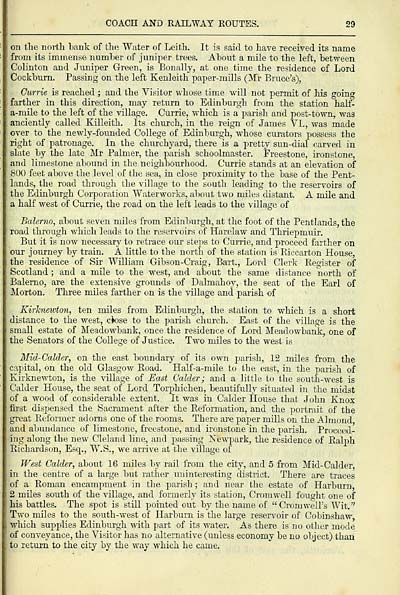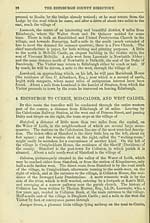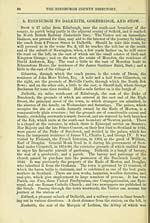Download files
Complete book:
Individual page:
Thumbnail gallery: Grid view | List view

COACH AND RAILWAY ROUTES. 29
on the north hank of the Water of Leith. It is said to have received its name
from its immense number of juniper trees. Ahout a mile to the left, hetween
Colinton and Juniper Green, is Bonally, at one time the residence of Lord
Cockhurn. Passing on the left Kenleith paper-mills (Mr Bruce's),
Currie is reached ; and the Visitor whose time will not permit of his going
farther in this direction, may return to Edinburgh from the station half-
a-niile to the left of the village. Currie, which is a parish and post-town, was
anciently called Killeith. Its church, in the reign of James VI., was made
over to the newly-founded College of Edinburgh, whose curators possess the
right of patronage. In the churchyard, there is a pretty sun-dial carved in
slate by the late Mr Palmer, the parish schoolmaster. Freestone, ironstone,
and limestone abound in the neighbourhood. Currie stands at an elevation of
800 feet above the level of the sea, in close proximity to the base of the Pent-
lands, the road through the village to the south leading to the reservoirs of
the Edinburgh Corporation Waterworks, about two miles distant. A mile and
a half west of Currie, the road on the left leads to the village of
Balerno, about seven miles from Edinburgh, at the foot of the Pentlands, the
road through which leads to the reservoirs of Harelaw and Thriepmuir.
But it is now necessary to retrace our steps to Currie, and proceed farther on
our journey by train. A little to the north of the station is Riccarton House,
the residence of Sir William Gibson-Craig, Bart., Lord Clerk Register of
Scotland ; and a mile to the west, and about the same distance north of
Balerno, are the extensive grounds of Dalmahoy, the seat of the Earl of
Morton. Three miles farther on is the village and parish of
Kirknewton, ten miles from Edinburgh, the station to which is a short
distance to the west, ciose to the parish church. East of the village is the
small estate of Meadowbank, once the residence of Lord Meadowbank, one of
the Senators of the College of Justice. Two miles to the west is
Mid-Calder, on the east boundary of its own parish, 12 miles from the
capital, on the old Glasgow Road. Half-a-mile to the east, in the parish of
Kirknewton, is the village of East Colder ; and a little to the south-west is
Calder House, the seat of Lord Torphichen, beautifully situated hi the midst
of a wood of considerable extent. It was in Calder House that John Knox
first dispensed the Sacrament after the Reformation, and the portrait of the
great Reformer adorns one of the rooms. There are paper mills on the Almond,
and abundance of limestone, freestone, and ironstone in the parish. Proceed-
ing along the new Cleland line, and passing JSTewpark, the residence of Ralph
Richardson, Esq., W.S., we arrive at the village of
West Calder, about 16 miles by rail from the city, and 5 from Mid-Calder,
in the centre of a large but rather uninteresting district. There are traces
of a Roman encampment in the parish; and near the estate of Harburn,
2 miles south of the village, and formerly its station, Cromwell fought one of
his battles. The spot is still pointed out by the name of "Cromwell's Wit."
Two miles to the south-west of Harburn is the large reservoir of Cobinshaw,
which supplies Edinburgh with part of its water. As there is no other mode
of conveyance, the Visitor has no alternative (unless economy be no object) than
to return to the city by the way which he came.
on the north hank of the Water of Leith. It is said to have received its name
from its immense number of juniper trees. Ahout a mile to the left, hetween
Colinton and Juniper Green, is Bonally, at one time the residence of Lord
Cockhurn. Passing on the left Kenleith paper-mills (Mr Bruce's),
Currie is reached ; and the Visitor whose time will not permit of his going
farther in this direction, may return to Edinburgh from the station half-
a-niile to the left of the village. Currie, which is a parish and post-town, was
anciently called Killeith. Its church, in the reign of James VI., was made
over to the newly-founded College of Edinburgh, whose curators possess the
right of patronage. In the churchyard, there is a pretty sun-dial carved in
slate by the late Mr Palmer, the parish schoolmaster. Freestone, ironstone,
and limestone abound in the neighbourhood. Currie stands at an elevation of
800 feet above the level of the sea, in close proximity to the base of the Pent-
lands, the road through the village to the south leading to the reservoirs of
the Edinburgh Corporation Waterworks, about two miles distant. A mile and
a half west of Currie, the road on the left leads to the village of
Balerno, about seven miles from Edinburgh, at the foot of the Pentlands, the
road through which leads to the reservoirs of Harelaw and Thriepmuir.
But it is now necessary to retrace our steps to Currie, and proceed farther on
our journey by train. A little to the north of the station is Riccarton House,
the residence of Sir William Gibson-Craig, Bart., Lord Clerk Register of
Scotland ; and a mile to the west, and about the same distance north of
Balerno, are the extensive grounds of Dalmahoy, the seat of the Earl of
Morton. Three miles farther on is the village and parish of
Kirknewton, ten miles from Edinburgh, the station to which is a short
distance to the west, ciose to the parish church. East of the village is the
small estate of Meadowbank, once the residence of Lord Meadowbank, one of
the Senators of the College of Justice. Two miles to the west is
Mid-Calder, on the east boundary of its own parish, 12 miles from the
capital, on the old Glasgow Road. Half-a-mile to the east, in the parish of
Kirknewton, is the village of East Colder ; and a little to the south-west is
Calder House, the seat of Lord Torphichen, beautifully situated hi the midst
of a wood of considerable extent. It was in Calder House that John Knox
first dispensed the Sacrament after the Reformation, and the portrait of the
great Reformer adorns one of the rooms. There are paper mills on the Almond,
and abundance of limestone, freestone, and ironstone in the parish. Proceed-
ing along the new Cleland line, and passing JSTewpark, the residence of Ralph
Richardson, Esq., W.S., we arrive at the village of
West Calder, about 16 miles by rail from the city, and 5 from Mid-Calder,
in the centre of a large but rather uninteresting district. There are traces
of a Roman encampment in the parish; and near the estate of Harburn,
2 miles south of the village, and formerly its station, Cromwell fought one of
his battles. The spot is still pointed out by the name of "Cromwell's Wit."
Two miles to the south-west of Harburn is the large reservoir of Cobinshaw,
which supplies Edinburgh with part of its water. As there is no other mode
of conveyance, the Visitor has no alternative (unless economy be no object) than
to return to the city by the way which he came.
Set display mode to: Large image | Transcription
Images and transcriptions on this page, including medium image downloads, may be used under the Creative Commons Attribution 4.0 International Licence unless otherwise stated. ![]()
| Scottish Post Office Directories > Counties > Midlothian (Edinburghshire) > Edinburgh county directory > (35) |
|---|
| Permanent URL | https://digital.nls.uk/85990555 |
|---|
| Description | Directories of individual Scottish counties or parts of counties. |
|---|
| Description | Around 700 Scottish directories published annually by the Post Office or private publishers between 1773 and 1911. Most of Scotland covered, with a focus on Edinburgh, Glasgow, Dundee and Aberdeen. Most volumes include a general directory (A-Z by surname), street directory (A-Z by street) and trade directory (A-Z by trade). |
|---|


